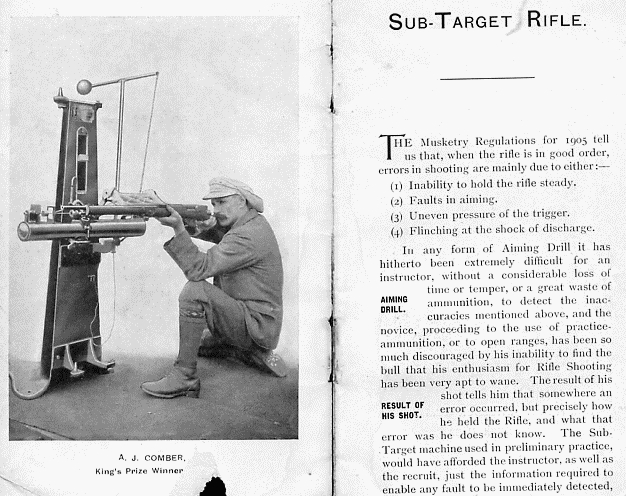 .
.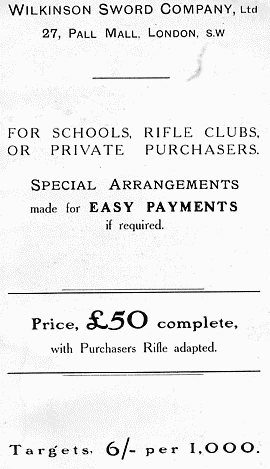
Please be aware that some specialist imagery may take time to load.
This site is designed for dedicated researchers on desktop or tablet, not ideal for mobile browsing.
by the Wilkinson Sword Co.
See also the: : LEE-ENFIELD PORTABLE SUB-TARGET DEVICE ~...MAUSER SUB-TARGET DEVICE ..~: HOLLIFIELD "DOTTER" .~.. CUMMINGS "DOT" RIFLE ~... PRACTICE RODS
Below, the front pages of the Wilkinson Sword company's brochure of 1906 are reproduced
The device was the invention of an American - Mr. Henry Havelock Cummings of Boston, Mass.,
and built under licence in Britain at a time when Lord Roberts and other senior military men and politicians were putting into force a plan to render every male subject of the United Kingdom well versed in the art of rifle shooting . This device is one of many which evolved to that end, not least of which was the setting up of the Society of Miniature Rifle Clubs.
..........................................................A.J. Comber....................................................................................................................................................................... this brochure's text is continued below
A.J. Comber, a Bisley King's Prize winner, is seen demonstrating the machine.
The rifle being used is a Magazine Lee-Enfield or Lee-Metford ( the "Long" Lee) - see also the S.M.L.E. (Short) Rifle.
Below is the specially adapted Lee-Metford rifle used with the Sub-Target Machine.
This particularly rare example is held in the National Firearms Collection of the Leeds Royal Armouries
and is shown by their kind permission.

Sadly no known example of the machine itself resides in the United Kingdom.
If you know of the whereabouts of an example, do please advise us.
Below: a drawing of the mechanism
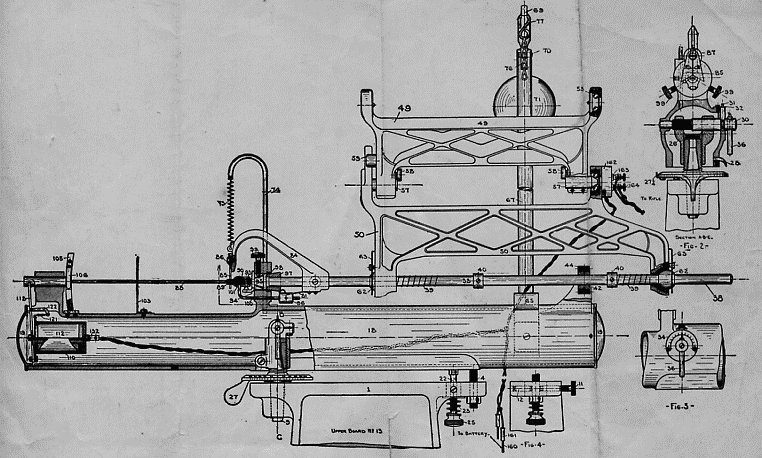
The continuing remainder of the brochure's text is here reproduced:
"and consequently more rapidly corrected. It is an instrument that records not only the actual result of a shot made at a mark,
but the position of the Rifle during the process of aiming and at the moment of pulling the trigger,
and thus demonstrating to the instructor the reasons for a hit or miss on the objective target.
DIFFICULTIES OF MARKSMANSHIP
If Rifles were constructed as cannon are, for firing from a rest, many of
the difficulties of marksmanship would disappear,
because the rest at moment of aiming would hold the weapon absolutely steady, but a man with a Rifle cannot do this.
In watching a good shot firing in the prone position, the barrel looks to be quite still.
But the marksman, holding a barely visible bull balanced on his fore-sight, is aware of more or less movement of the Rifle,
and knows how very slight a tremor will spoil his shot.
The novice very soon knows that too, but it comes with something of a shock to him to realise that tremor
in his case is frequently represented by a wobble that may send the bullet to the edge of the target,
over it, or anywhere round the face of the clock.
PRINCIPLE OF SUB-target RIFLE
The principle of the Sub-target Rifle can be explained without a great deal
of difficulty.
In the illustrations it will be seen that a strong and heavy upright pillar supports, in any position required—standing, kneeling, or prone—the head.
Above this head is placed a delicate rod with a universal movement.
At the forward extremity of the rod a needle point is fixed, and in a little grooved frame a target, about the size of a visiting card, is placed.
That is the Sub-target. The objective target is an ordinary one, placed preferably at 30 yards range,
which is ringed to proper dimensions to appear the size of a standard target at any desired distance, say 200 or 500 yards.
ORDINARY RIFLE IS USED - PERFECT FREEDOM OF MOVEMENT
An ordinary Rifle is used for taking aim, and it is so
ingeniously connected to the machine that there is no point of rest. The
weight or the parts attaching the Rifle to the instrument is exactly balanced
by the weight of the counterpoised ball seen in the illustrations, so that
the marksman has only the weight of the Rifle to support, aud sufficient
freedom of movement is given to allow of the Rifle being aimed off the target
in any direction. The rifle connections are mounted on ball bearings, and
are connected to the steel rod which is swung on a four-point universal
joint on tlie " head " of the machine.
This rod moves coincidentally with the line of sight along the rifle barrel,
and transfers its gyrations, through an ingenious ball differential movement,
to the needle. The relation of the objective target 20 yards away and the
Sub-target on the
machine itself is determined by calculation of angles, but to allow for
variations in eyesight, or constant peculiarities of aiming, the "
head " may be adjusted both vertically and horizontally by means of
screws. These variations from the normal are- recorded on two dials, one
corresponding to degrees of elevation on the back sight, and the other to
lateral movement for windage. In using the machine, the marksman may first
sight the Rifle with the radial rod locked, so that if any adjustments are
necessary to get the sights properly aligned on the bull's eye these adjustments
can be made. The radial rod is then released, the Rifle cocked, and the
marksman aims at the objective target and pulls the trigger.
SLIGHTEST MOVEMENT INDICATED
On the tiny Sub-target every movement of the Rifle is indicated
by the delicate pointer until at the pulling of the trigger the card, darts
forward and takes the impress of the needle, exactly corresponding to the
aim on the objective target.
BUT THEY CANNOT SHOOT
In many of the public schools of the country, military
organisations exist and military tactics are taught. The boys march
well and go through the manual of arms without a hitch, but they cannot
shoot. It is considered unsafe to allow the schoolboys to practise shooting
with loaded Rifles as some serious accidents have happened. It is a matter
of much interest and a cause for congratulation that the schools are becoming
interested in the Sub-target Rifle—which is safe as it is used without
ammunition—and are beginning to adopt it for instructing the boys
in marksmanship.
Eton was the first College in England to adopt this apparatus. This remarkable
machine, it will be understood, requires no attention beyond the preliminary
setting, as the little Sub-target is electrically actuated. There is a dry
battery in the pillar, and the head contains a powerful magnet, the armature
of which impels the target on to the needle when the circuit is closed.
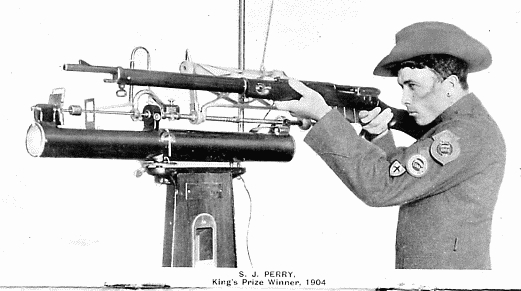
BLANK CAN BE USED
This closing of the circuit results from pulling the trigger. There can be used, if desired, a blank cartridge in the Rifle,
but as the apparatus is designed for aiming, not for shooting,
this serves no purpose beyond that of accustoming the user to the noise of the discharge.
It has also been found excellent training to get men used to the explosion
by mixing blank cartridges with empty shells,
so that the marksman must always anticipate the explosion although it only occasionally occurs.
WINDAGE ALLOWANCE CAN BE TAUGHT
Windage allowance can be taught, by the instructor purposely deflecting
the apparatus from its normal direction,
with the aid of a lateral adjustment lever. Magazine pratice can be carried
out on the Sub-target Rifle.
Any kind of target can be used except the "running man," and the
reports prove that the instrument is capable of being used
to great advantage with the disappearing target, as well as for snap shooting.
Some of the places where the Apparatus has been installed and can be inspected. ( as at 1906 !)
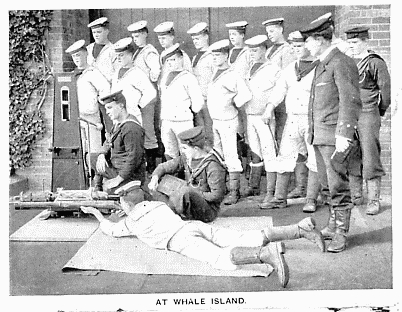
H.M.S. "Excellent",
Marine Barracks, Chatham
,, ,, Portsmouth
,, ,, Devonport
H.M.S. "Grarton"
Royal Military College, Camberley
Royal Military Academy, Woolwich
Guards' Depot, Caterham
Eton College
Cheltenham College
Dover College
Royal Horse Guards
11 th Hussars—Curragh
King's Dragoon Guards
7th Dragoon Guards
21st Lancers—Hounslow
13th Hussars—India
1st Battalion Grenadier Guards
3rd „
1st Battalion Coldstream Guards
2nd
3rd
1st ,, Scots Guards
2nd
3rd
Irish Guards
2nd Bn. Lincoln Regiment
1 st , Royal Welsh Fusiliers
2nd , Black Watch—India
3rd , „
2nd , Northumberland Fusiliers
1st , Norti Staffordshire Regiment
2nd ,
(Continued.)
1st Bn. West Riding Regiment—Bombay
3rd , Northamptonshire Regiment
1st , South Wales Borderers
2nd ,
1st , Yorks Light Infantry—Gibraltar
2nd ,
1st , Rifle Brigade—Malta
1st , Royal Irish Rifles—India
1st , Seaforth Highlanders
Somersetshire Light Infantry
Scottish Horse—Blair Athol
„ —Transvaal
Middlesex Imperial Yeomanry
Bombay and Baroda Railway Volunteers
Malay States Guides
East London R.E. Volunteers
3rd V.B. Royal Fusiliers
1st V.B. York and Lane. Regiment
The Stock Exchange Rifle Club
The Southfields
The Eglingham
St. Anne's Asylum, Redhill
Sussex County Cricket Club
rders for Machines have also teen received on
behalf of
H.I.M. The Sultan of Turkey
The Roumanian Government
The Maharajah of Gwalior
Kaid Sir Harry Maclean for the Sultan
of Morocco.
The Duke of Manchester
The Countess of Dysart
The Marquis of Tullibardine
The Emperor of Abyssinia
Messrs. Walter Locke & Co., Calcutta.
***********************************
At 1024 x 768 pixel resolution these targets should be shown near actual size
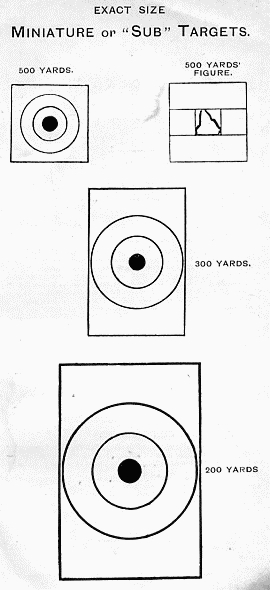
Return to: SITE MAP or MENU PAGE or TOP of PAGE
THE SUB-TARGET GUN COMPANY.
GENTLEMEN,—It affords me pleasure to testify to the value of the Sub-target
Rifle, one of which was set up on the steamer,
and was in constant use by the members of the Canadian Rifle Team during
the voyage from Montreal to Liverpool, and
afterwards at the Canadian Headquarters at Bisley, where it was in almost
constant use. I consider it of great value in the
instruction of recruits in holding and sighting, and also in detecting and
correcting the individual errors of eyesight. For
practice in trigger-pulling it is of great advantage, even to the experienced
marksman.
My daily use of the Machine at Bisley, was, I feel, of advantage to me in
my work on the ranges, where I was winner
of the King's Prize.
Very truly yours, (Signed) S. J. PERRY, Gold Medalist, 1904.
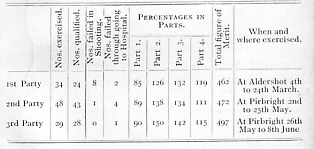
***********************
BISLEY CAMP, SURREY.
24th July, 1905.
THE SUB-target GUN COMPANY.
GENTLEMEN,—Having used the Sub-target Rifle frequently during the
N.R.A. Meeting at Bisley, just closed,
I am pleased to testify to its value in promoting steadiness in holding, sighting and trigger-pulling,
To the recruit it must be especially useful in these respects, as the tell-tale "needle " points out every "fault" of the man,
I believe that its general adoption and use by the Army, Navy, Volunteers, Rifle Clubs
and in the Public Schools would go a long way towards making a nation of reliable shots for " Imperial Defence."
Very truly yours.
(Signed) ALF. J. COMBER.
Gold Medalist, 1905.
***************
Copy of Report received from
THE MUSKETRY CAMP AT PIRBRIGHT.
Referring to your letter of the 15th inst., I have prepared a table showing
the various figures of merit obtained by parties of
recruits that have been exercised by me this year. I have another party
here now, and I think they will do as well as the 3rd party on my table
did. The figures, I think, show a wonderful improvement in their shooting,
which must largely be attributed to ihe Sub-target Rifle. At first when
I had the Machine I was very much afraid of it being damaged if used without
an instructor or responsible person who understood it being present, but
since I spoke to Mr. Stratton on this point I have let all my men use it
as they like, and it is seldom idle for a second from morning till night.
It tends to a great extent to make musketry training more interesting, as
it is a very interesting instrument to use, and to a large extent the use
of it here by my men has rendered the tedious musketry parades no longer
necessary. If I had another Machine it would be also used continuously,
as there is great keeness to practice with the present one.
Several men when they are practicing with the Machine won't give it up till
they have shot a good card with it. I make a point of making every man practice
with it daily under the tuition of his own instructor. As I have about 42
men down here, and allow them only five minutes each, it takes three and
a half hours to get them all through, and when three hours are spent on
the range, it does not leave much spare time. The ease with which a recruit
can be taught to shoot well on it alone is astonishing.
In the cases of recruits that develop the common faults called "bobbing"
and "jerking the trigger," these faults can
all be overcome with practice on the Sub-target Rifle. If recruits are taught
shooting on this instrument from the
beginning they can't help becoming good shots.
Copy of Preliminary Report on SUB-target RIFLE, Whale Island Staff.
This instrument has now been under trial for three months, and has been
constantly used during this period for training the
boys of H.M.S. "St. Vincent." A statement of the results so far
obtained is attached. The Machine is still in good order, and in daily use,
the only parts that have given trouble being two of the electric contacts,
these having been put in order, and slightly modified, the whole arrangement
is now found to be very reliable.
When the short rifle is adopted (ed: the
S.M.L.E.), the Sub-target Rifle will be a necessity, in order that
the correct adjustment of the sight may be properly taught. No other system
can do this.
I consider the Machine of very great value for teaching new entries and bad shots, and to fire properly. It is of especial value in showing up any individual who "pulls" or "bobs." It is particularly noteworthy that the superiority of the training given by the Machine is shown in the vanishing target practice and snap-shooting, The comparison given is not quite fair to the Machine, as some boys not trained with it were found to be extremely bad and unable to hit a target. Such boys were sent back, and were practised at the Machine, where their faults were invariably noticed and corrected. Blank ammunition has been used in conjunction with the Machine.
********************
"ST. VINCENT.'
AVERAGES OF 100 BOYS' FIRINGS.
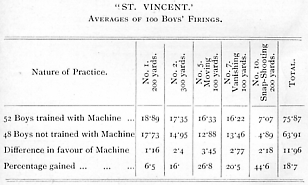
Copy of Letter from
COMMANDER H. CHRISTIAN, R.N.
(H.M.S. "Excellent"),
dated 20th June, 190&.
DEAR SIRS,—We have had the Sub-target Rifle in use here for a good
number of months now. Its value as a teacher of the art of rifle shooting
is undoubted, and superior to anything else yet invented—bar with
unlimited practice with the actual rifle, of course. The results we have
produced with the "St. Vincent" boys are quite extraordinary,
and I should imagine that the Army will " go for it " for all
they are worth directly they see it at work.
Sincerely yours,
(Signed) HAROLD CHRISTIAN,
I HE WILKINSON SWORD COMPANY, LIMITED.
***************
Copy of Further Report received from
SENIOR STAFF OFFICER, Whale Island,
dated 19th June, 1905.
We do not teach moving target with Sub-target Rifle, only a form of vanishing
or snap-shooting target, this by fitting a
shutter over a special target, and working it by a string and weight. As
the boy may not come to the "present " till he sees
his target, it does not matter much if he knows pretty well where it is.
We leave the target in sight for four or five seconds, and
have a special target and sub-TARGETS which we make, and so reproduce our
range conditions as nearly as possible. The
Machine is working very well indeed, and the boys do extraordinarily well
after using it. The last lot beat a class of old
hands, and good old hands at that, that is to say, men who were doing advanced
course of gunnery to better themselves, and so were keen.
********************
Copy of Letter from
ETON COLLEGE, dated 22nd June, 1905.
ORDERLY ROOM, ETON COLLEGE.
DEAR SIR,—I regret I am unable as yet to make a full report on the
Sub-target Rifle Machine, owing to the short time
it has been in our possession. The Shooting VIII. and those who are qualifying
have been exercised ; they show the greatest
keenness and interest in the practice. The Second Squad of Recruits were
exercised this morning for the first time—they will
have seven more half hours before going on the range to fire their course.
I will then let you know the result, comparing the
squad trained with the S.T.R. and a squad trained with the Morris Tube.
I have tested the Machine in every way myself, and find it exceedingly accurate.
It shows every movement of the rifle and
every fault made by the shooter, such as bobbing, pulling, jerking, taking
too much or too little foresight. On wet days it
will be invaluable.
I remain, Yours truly, G. A. SOLTAU-SYMONS.CAPT.
A/ADJT. E.C.R.V "
*************************
The target frames are reminiscent of those used nearly forty years later for the Swift Training Rifle
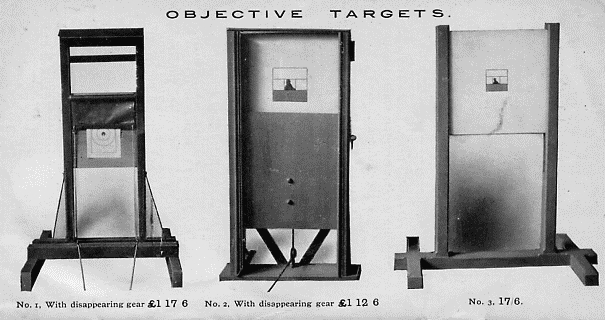
E.J.D.
Newitt wrote of the machine, in some detail, in his 1906 book "
The Citizen Rifleman
He evidently saw much advantage in the system
Another phase in the development of appliances for teaching
marksmanship is one in which the rifle is used without ammunition. The office
performed by ammunition in target practice is to indicate the accuracy of
aim at the instant of discharge, which its projectile does within the limits
of its own and the rifle's accuracy. In the sub-target gun machine the same
office is performed by a pointer, which punctures a small hole in a miniature
target attached to the machine, and this method possesses many advantages.
In the first place, the cost of ammunition is avoided, whilst no range is
required; and in the second, there are so many circumstances other than
incorrectness of aim which cause a misplaced hit, that the position is not
always a reliable guide for enabling the instructor to diagnose the cause.
Inaccuracy of rifle and ammunition will falsify the most perfect aim and
discharge, and when even this is beyond suspiciond, unsteady hold and discharge,
the most frequent of causes are not observable whilst actually taking place.
Consequently the most careful instructor may easily misconceive the true
cause and lead his pupil farther astray by his instructions for correcting
it.
When using the rifle in conjunction withth the sub-target gun machine every
movement of the rifle whilst aiming at the target is duplicated on a smaller
scale by the pointer, which moves over the face of the sub-target immediately
under the instructor's eye. When the trigger is pulled the sub-target instantaneously
responds by jumplng forward and, in coming sharply in contact with the pointer,
receives an, indelible record, which exactly corresponds with the position
the hit would have occupied had the rifle been actually fired with a cartridge.
Throughout the act of aiming the instructor has been able to observe every
movement, and can say with certainty whether the aim was correct or otherwise,
or if his pupil "pulled off " badly.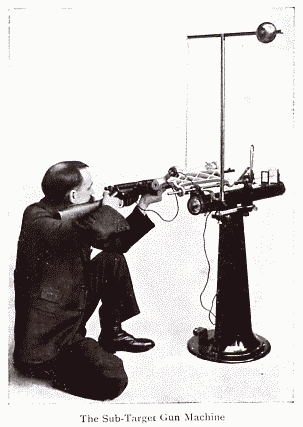
It has been found very difficult to produce an illustration which fully
explains the machine and its operations. The rifle is attached by freely
moving pivots to a cradle, which is in turn pivoted by a universal joint
to the pointer. A convenient stand supports the whole mechanism. A pair
of electric contacts close a circuit when the trigger is pulled and actuate
the sub-target, The wei^ of the cradle, which would otherwise be added to
the rifle, is counterpoised by the weight seen at the end of its supporting
arm. The rifle is held and aimed at an ordinary target placed at adistance,
and all its movements are conveyed to the pointer through the universal
joint. Immediately in front of the pointer is a target having exactly the
same ratio of size to the target aimed at with the rifle as the movements
of the pointer have to the movements of the rifle.
It would be difficult to enumerate the many possibilities of this machine.
For instruction in the first principles of aiming, holding, and discharge
it is invaluable, and may be used in barracks, schools, and institutes by
day, or in artificial light, thus prolonging the hours during which instruction
may be given. On the range, when the shooter is performing wildly, an adjournment
to the sub-target gun machine will generally determine the cause before
much costly ammunition is wasted, and after a few minutes' instruction he
may resume firing in the ordinary way with increased confidence and improved
results.
Even the experienced marksman may sometimes learn that the cause of that
unaccountable outer might more reasonably have been attributed to a bad
pull-off than a change of wind.
Regular contests can be held on the machine, and afford the most useful
practice to marksman and novice alike. The entire absence of any element
of danger renders it particularly suitable for use in schools; indeed, it
is already largely so used in the United States of America, where the annual
inter-school championship contest is an event to which great public interest
attaches. Its merits are fully recognised in England, and machines are now
in use at the School of Musketry at Hythe, the Royal Military Academy, Woolwich,
in the Royal Navy, and at the headquarters of many Regular and Volunteer
regiments. The cost of £50 is an item against which may be set off
the cost of ammunition, which would otherwise be necessary, and in some
cases the cost of erecting and equipping a range.
The greatest credit is due to Mr. H. H. Cummings, the inventor, whose ingenuity
has produced a device which overcomes many of the technical difficulties
incidental to the teaching of marksmanship, and minimises, most of those
caused by the necessity, hitherto, of using ranges and ammunition, which
may now be postponed to a later stage, when the pupil has acquired sufficient
skill in the first principles to study the factors introduced by his ammunition,
without wasting it.
Below; images from the pamphlet " The Sub-target Gun Machine"
of "The Sub-target Gun Co." -Hight St., Boston, Mass. U.S.A.
firstly in use Standing and Kneeling
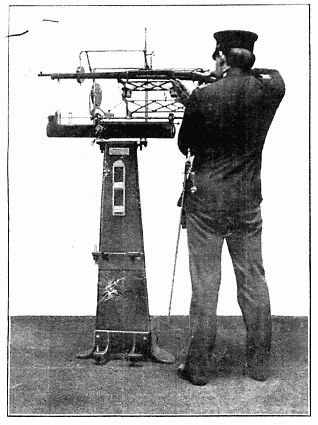
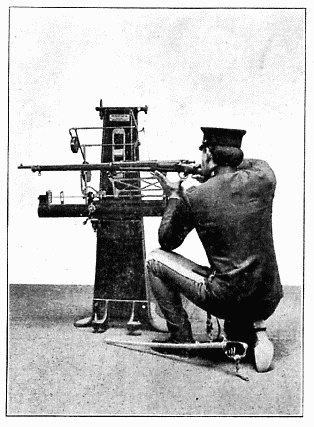
and prone.
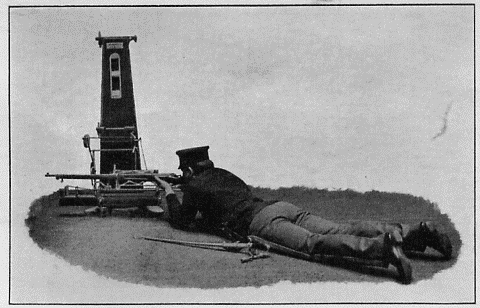
We are most grateful to have been been passed images of a postcard sent to the American N.R.A. in April 1908.
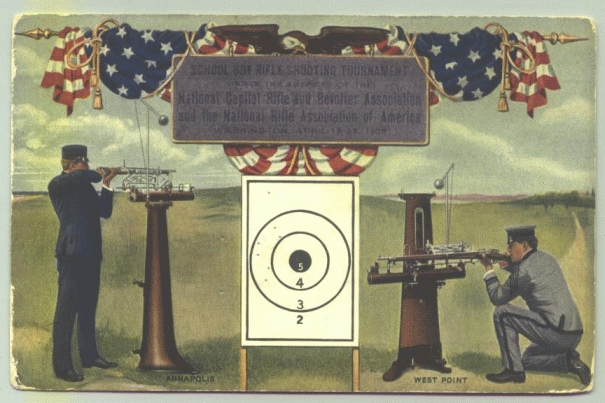
The postcard depicts the use of the machine during the
"SCHOOL BOY RIFLE SHOOTING TOURNAMENT
under the auspices of the Capitol Rifle and Revolver Association
and the National Rifle Association of America
WASHINGTON April 7-25 1908"
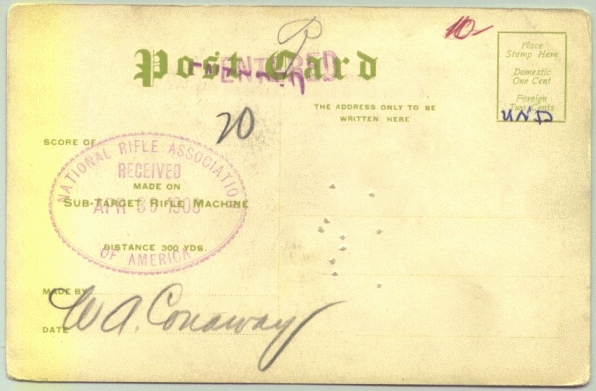
Postcard images kindly provided by Brian Woodall of the N.S.R.A. of Great Britain.
Written about in America, where it was originally designed,
the Sub-Target machine was covered by the journal "Scientidfic American" in October 1903
A facsimile of the article is shown below.
A higher resolution image can be viewed by clicking on the image.
The machine was also covered in another paper
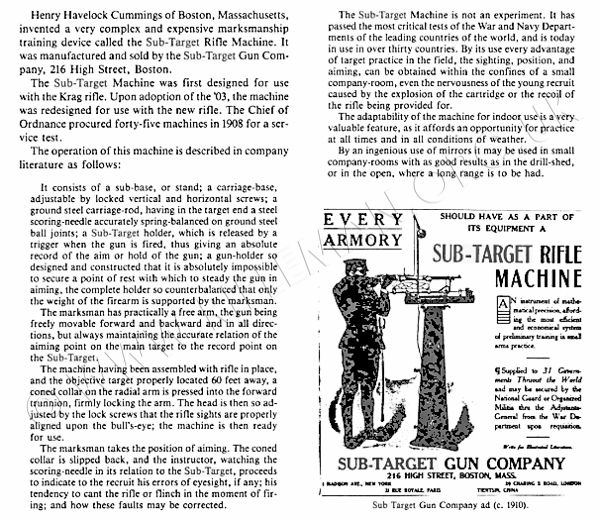
The man himself was portrayed in a company brochure.
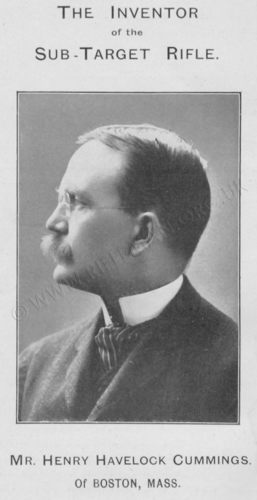
Finally, we illustrate e a report given in C.B. Fry's Magazine of 1906, containing some fine photographs.
This can be viewed as a flip-page document, both searchable and zoomable.
See also the: .: S.M.L.E. SUB-TARGET DEVICE ~...MAUSER SUB-TARGET DEVICE ..~: HOLLIFIELD "DOTTER" .~.. CUMMINGS "DOT" RIFLE ~... PRACTICE RODS
the British "Swift Training Rifle "and the Canadian "Long Branch Training Rifle" of 1943 vintage.
Return to: TOP of PAGE
See this website's Raison d'être